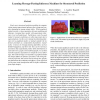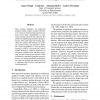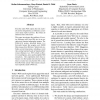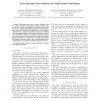132
click to vote
CVPR
2011
IEEE
14 years 8 months ago
2011
IEEE
Nearly every structured prediction problem in computer vision requires approximate inference due to large and complex dependencies among output labels. While graphical models prov...
115
click to vote
EMNLP
2010
14 years 10 months ago
2010
We present a novel approach to relation extraction that integrates information across documents, performs global inference and requires no labelled text. In particular, we tackle ...
109
click to vote
NAACL
2010
14 years 10 months ago
2010
Most learning algorithms for undirected graphical models require complete inference over at least one instance before parameter updates can be made. SampleRank is a rankbased lear...
98
Voted
NAACL
2010
14 years 10 months ago
2010
Recently, relaxation approaches have been successfully used for MAP inference on NLP problems. In this work we show how to extend the relaxation approach to marginal inference use...
117
Voted
EMNLP
2010
14 years 10 months ago
2010
With the proliferation of user-generated articles over the web, it becomes imperative to develop automated methods that are aware of the ideological-bias implicit in a document co...
112
click to vote
EMNLP
2010
14 years 10 months ago
2010
Even the entire Web corpus does not explicitly answer all questions, yet inference can uncover many implicit answers. But where do inference rules come from? This paper investigat...
95
Voted
ACL
2010
14 years 10 months ago
2010
Many NLP tasks need accurate knowledge for semantic inference. To this end, mostly WordNet is utilized. Yet WordNet is limited, especially for inference between predicates. To hel...
PERCOM
2010
ACM
14 years 11 months ago
2010
ACM
—This paper shows how to reduce evaluation time for context inference. Probabilistic Context Inference has proven to be a good representation of the physical reality with uncerta...
122
click to vote
PAMI
2010
14 years 11 months ago
2010
—We present a generative model and inference algorithm for 3D nonrigid object tracking. The model, which we call G-flow, enables the joint inference of 3D position, orientation, ...
81
Voted
AMAI
2002
Springer
15 years 14 days ago
2002
Springer
: It is claimed that human inferential apparatus offers interesting ground in order to consider the intuitions of artificial intelligence researchers about the inference patterns a...





